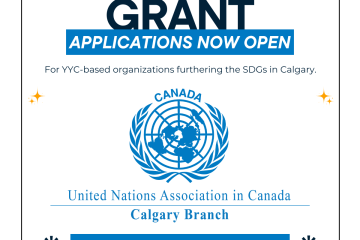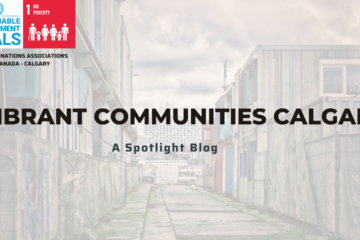Hunger and Poverty: The Temporal Horrors of the World
By: Angelina Patoka
In October, the United Nations marks two important dates. The World Food Day on October 16, and the International Day for the Eradication of Poverty on October 17. The former is associated with UNSDG 2: Zero Hunger, while the latter is associated with UNSDG 1: No Poverty. The two Goals are completely interwoven and present challenges to human security worldwide.
This article explores how these two UNSDG Goals are connected to global problems, how they are connected to Calgary, and what we can do about it.
UN SDG Goal 1: No Poverty, is compounded by daunting prospects since the global pandemic began. The United Nations states that the health crisis has led to “the first rise of extreme poverty in a generation,” which includes an estimated global poverty rate of seven per cent by 2030. This suggests that about 600 million individuals worldwide are expected to live in extreme poverty. Canada’s extreme poverty rate according to Canada’s Official Poverty Line was 11 per cent, about 3.9 million individuals, in 2018.
More recently, a 2021 report by Statistics Canada concluded that 3.7 million Canadians were living below the poverty line.
This may seem like an odd improvement amidst a global pandemic, but one must keep in mind that the way poverty is measured is highly contested. For example, some countries do not differentiate between relative poverty and absolute poverty. Both are obviously terrible, but they could carry different implications for policymaking.
Adding to this complication is the fact that Canada does not have an official poverty measure. Nevertheless, one thing most experts and the federal government agree on is that the pandemic exposed Canada’s vulnerabilities with regard to social safety nets like the Employment Insurance program. The unemployment rate in Canada returned to the pre-pandemic level of 6.9 per cent this September. This is encouraging, but it does not necessarily reflect on national betterment because poverty in Canada is oftentimes measured by assessing the levels of income rather than employment rates and it is affected by additional variables such as inflation.
Calgary faces similar problems with measurement. However, according to some accounts the pre-pandemic poverty rate was 12 per cent, which rose by about 77,000 persons during the pandemic according to a study conducted by Vibrant Communities Calgary (VCC).
Other critical factors contributing to poverty in Calgary include the multi-layered struggles of marginalized and racialized groups, Indigenous Peoples, and immigrants who tend to make less than the average Calgarian income.
The municipal government recognizes poverty as a major problem and has set ambitious goals as part of a partnership with VCC and its community-driven strategy Enough for All.
To combat poverty in Calgary, Enough for All introduced three goals: (I) that all Calgarians live in a strong, supportive, and inclusive community, (II) that all Calgarians have sufficient income and assets to thrive, and lastly (III) that all Indigenous People are equal participants in Calgary’s future. The most prominent feature of this strategy are the 10 Levers of Change.
The Levers represent ten areas of focus that must be addressed to reduce and perhaps eventually eradicate poverty in the city. Upon closer inspection, one might notice its similarities to the UNSDGs as the Levels include topics like education, employment, and food security.
UNSDG Goal 2: Zero Hunger, is directly linked to Goal 1. It envisions a world where everyone has access to nutritious food from sustainable sources on a regular basis. That being said, the number of people suffering from hunger is markedly larger than those suffering from extreme poverty. At least in terms of how poverty is being measured in the present.
Food insecurity, be it hunger or malnutrition, is estimated to affect two billion people.
This includes malnutrition that results in overweight issues and obesity that are largely a Western problem. Food insecurity is also linked to global soil health and climate change, which facilitate a range of problems that hinder the UNSDG 2’s recommendation that global food systems ought to be transformed to create sustainable food security worldwide.
Another persistent problem with food insecurity is how hunger is still weaponized against vulnerable populations in places like the war-torn Tigray region in Ethiopia, and likewise war-torn Syria. It only takes a few minutes to browse the World Food Programme’s (WFP) briefs on at-risk countries and regions to appreciate the frightening scale of the problem.
Though Canada does not share the horrifying problems faced by many Ethiopians, Eritreans, Syrians, and Kurds among other peoples, it is described as an essential partner to the WFP. This decades-long collaboration recently culminated in the opening of a WFP office in Ottawa in 2020.
While global humanitarian action by Canada may imply that its own food insecurity issues are solved that is untrue.
A big hint to the existence of food insecurity in Canada are all the food banks and non-profits that strive to end hunger and malnutrition. While Canada’s circumstances are incomparable to a place like Syria, there are still serious problems that need to be addressed.
Health Canada monitors food and nutrition indicators that revealed how 14.6 per cent of Canadians experienced food insecurity in 2020.
In addition, data collected by institutions like the University of Alberta found that food insecurity in Canada is on the rise. 11 per cent of Albertans were food insecure in 2014, and according to Statistics Canada the percentage grew to 12.9 in 2018.
Calgarians are not immune either as up to 21 per cent of the city’s residents reportedly struggled to buy groceries as of April 2020 and food charities like the Calgary Food Bank struggled to meet demand alongside the rest of the non-profit sector nationwide.
What do we do about food security in Calgary and Canada?
Abacus Data found that one of the number one key issue of interest to Canadians during the 2021 Elections were living costs. The rising prices of imported foods and inflation are vital (if not existential) concerns for Canadians and the federal government alike, but there are no easy and direct solutions to such problems.
However, while there are some external pressures that Canada must bear there are local solutions we can engage in as well. Surprisingly or not, many of them align with Goal 2’s recommendations and the UNSDGs’ overall message regarding sustainability and communal reciprocity.
In the words of Patrick Cloutier from the Calgary-based The SolFood Project, this entails compassion and understanding towards those who are struggling, learning more about food, and perhaps getting into gardening.
The ramifications of the failures of UNSDG 1 and UNSDG 2 are scarier than any horror film and any survival video game. Don’t sleep on those potential disasters, but don’t be afraid.
While the federal government busies itself with international humanitarianism, there are things we can do to alleviate poverty and food insecurity on a local level.
Resources for knowledge and help:
- Vibrant Communities Calgary/ Enough for All homepage: https://enoughforall.ca.
- Enough for All – Ward Poverty Profiles: https://enoughforall.ca/action/poverty-profiles-2021.
- Alberta Health Services – Free Food: https://www.albertahealthservices.ca/nutrition/Page16163.aspx.
- Calgary Food Bank: https://www.calgaryfoodbank.com.
- United Way – How you can help with food security in Calgary: https://calgaryunitedway.org/blog/how-you-can-help-with-food-security-in-calgary/.
- Grow Calgary: https://www.growcalgary.ca.
- Calgary Horticultural Society – Find a community garden: https://www.calhort.org/resources/find-a-community-garden/.
———————————————————
Angelina Patoka is an University of Calgary undergraduate student who is starting the fourth year of her combined political science and international relations degree. She is interested in all aspects of global governance, particularly security issues stemming from international conflicts and disagreements. Angelina began volunteering with UNAC Calgary in late 2020 and she is excited to share and discuss how Canada is affected by ever-evolving globalism.


